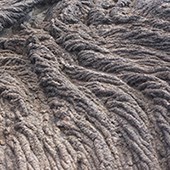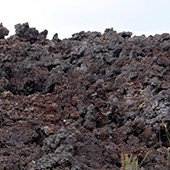|
According to Native Hawaiian tradition, molten lava is the manifestation of Pele— the volcanic deity and creator of new lands. She is a rejuvenating and creative force, reshaping the landscape with each eruption. Indeed, molten lava that reaches the surface during volcanic eruptions is still adding mass to the island of Hawaiʻi. The island itself is made up of flows that have built upon one another over many thousands of years.

NPS Photo/J. Wei 
Pāhoehoe lava appears smooth and ropy. It moves slower and stays hotter than ʻaʻā lava. When flowing, it can form lava tubes and may have many flow units known as "toes" because it is more runny and less viscous. 
Most flows consist of both pāhoehoe and ‘a‘ā at various points, though the proportion of each can vary widely. Pāhoehoe upstream often changes to ‘a‘ā downstream. Although it is possible, ‘a‘ā flows transition into pāhoehoe less often. Lava or Magma?Magma and lava are the same substance, but in different places. The term magma refers to molten rock that is still within the earth. Once it breaks through the earth's surface, it is referred to as lava.How HOT is Hot Lava?The temperature of erupting lava from Kīlauea is about 2,100 degrees Fahrenheit (1,150 degrees Celsius). Erupting lava cools quickly when it is exposed to air, hundreds of degrees per second, though rocks may steam for years after an eruption.Why Don't Hawaiian Volcanoes Explode As Violently As Others?Although powerful, Hawaiian volcanic eruptions are famous for being relatively benign and approachable, in comparison with volcanoes elsewhere. Hawaiian eruptions are not nearly as explosive as those like Mount St. Helens in 1980. The reason for this lies in the chemical composition of the magma that feeds these volcanoes.Hawaiian magma contains comparatively little silica and is highly fluid. Accordingly, it can flow relatively freely and release gas easily. On the other hand, the magma of volcanoes located along the edges of tectonic plates, such as Mount St. Helens, has a different composition that makes it much more viscous (less fluid). It tends hold more gas and break apart, possibly explosively, during eruptions. The easy flowing, fluid nature of lava from Hawaiian volcanoes contributes to their shape and is why they are referred to as shield volcanoes. Lava easily flows down the sides of the volcano, giving it a rounded appearance like a Roman warrior's shield. 
What Does Lava Sound Like?An episode of the Voices of Science podcast from the National Park Service explores lava and features sounds of the 2008-2018 summit lava lake and flows from Puʻuʻōʻō.
Learn about some of the previous eruptions of Kīlauea and Mauna Loa
|
Last updated: December 6, 2023
